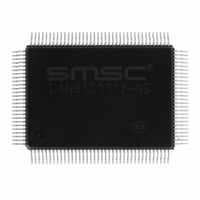LAN91C111I-NS SMSC, LAN91C111I-NS Datasheet - Page 59

LAN91C111I-NS
Manufacturer Part Number
LAN91C111I-NS
Description
IC ETHERNET CTLR MAC PHY 128-QFP
Manufacturer
SMSC
Type
Single Chip MAC and PHYr
Datasheet
1.LAN91C111-NU.pdf
(128 pages)
Specifications of LAN91C111I-NS
Controller Type
Ethernet Controller, MAC/PHY
Interface
Serial EEPROM
Voltage - Supply
3.3V
Operating Temperature
-40°C ~ 85°C
Mounting Type
Surface Mount
Package / Case
128-QFP
Product
Ethernet Controllers
Number Of Transceivers
1
Standard Supported
IEEE 802.3 or IEEE 802.3u
Data Rate
10 Mbps or 100 Mbps
Supply Voltage (max)
5 V
Supply Voltage (min)
0 V
Supply Current (max)
140 mA
Maximum Operating Temperature
+ 85 C
Ethernet Connection Type
100BASE-T or 100BASE-T4 or 100BASE-TX or 10BASE-T
Minimum Operating Temperature
- 40 C
Mounting Style
SMD/SMT
Lead Free Status / RoHS Status
Lead free / RoHS Compliant
Current - Supply
-
Lead Free Status / Rohs Status
Lead free / RoHS Compliant
Other names
638-1014
Available stocks
Company
Part Number
Manufacturer
Quantity
Price
Company:
Part Number:
LAN91C111I-NS
Manufacturer:
RECOM
Quantity:
1 000
Company:
Part Number:
LAN91C111I-NS
Manufacturer:
SMSC
Quantity:
1 000
Company:
Part Number:
LAN91C111I-NS
Manufacturer:
Standard
Quantity:
6 916
Company:
Part Number:
LAN91C111I-NS
Manufacturer:
Microchip Technology
Quantity:
10 000
10/100 Non-PCI Ethernet Single Chip MAC + PHY
Datasheet
SMSC LAN91C111 REV C
8.17
OPERATION
CODE
110
111
Reserved
0
Bank 2 - Packet Number Register
Note:
COMMAND SEQUENCING
A second allocate command (command 1) should not be issued until the present one has completed.
Completion is determined by reading the FAILED bit of the allocation result register or through the
allocation interrupt.
A second release command (commands 4, 5) should not be issued if the previous one is still being
processed. The BUSY bit indicates that a release command is in progress. After issuing command 5,
the contents of the PNR should not be changed until BUSY goes low. After issuing command 4,
command 3 should not be issued until BUSY goes low.
BUSY BIT - Readable at bit 0 of the MMU command register address. When set indicates that MMU
is still processing a release command. When clear, MMU has already completed last release
command. BUSY and FAILED bits are set upon the trailing edge of command.
PACKET NUMBER AT TX AREA - The value written into this register determines which packet number
is accessible through the TX area. Some MMU commands use the number stored in this register as
the packet number parameter. This register is cleared by a RESET or a RESET MMU Command.
Reserved
When using the RESET TX FIFOS command, the CPU is responsible for releasing the memory
associated with outstanding packets, or re-enqueuing them. Packet numbers in the completion
FIFO can be read via the FIFO ports register before issuing the command.
MMU commands releasing memory (commands 4 and 5) should only be issued if the
corresponding packet number has memory allocated to it.
DECIMAL
VALUE
6
7
OFFSET
0
2
COMMAND
ENQUEUE PACKET NUMBER INTO TX FIFO - This is the normal method of
transmitting a packet just loaded into RAM. The packet number to be enqueued
is taken from the PACKET NUMBER REGISTER.
RESET TX FIFOs - This command will reset both TX FIFOs: The TX FIFO
holding the packet numbers awaiting transmission and the TX Completion FIFO.
This command provides a mechanism for canceling packet transmissions, and
reordering or bypassing the transmit queue. The RESET TX FIFOs command
should only be used when the transmitter is disabled. Unlike the RESET MMU
command, the RESET TX FIFOs does not release any memory.
0
PACKET NUMBER
REGISTER
NAME
DATASHEET
0
PACKET NUMBER AT TX AREA
59
READ/WRITE
0
TYPE
0
SYMBOL
PNR
0
Revision 1.91 (06-01-09)
0













